Environment Vs Economy: An Approach That Exposes India To COVID-19-Like Infections
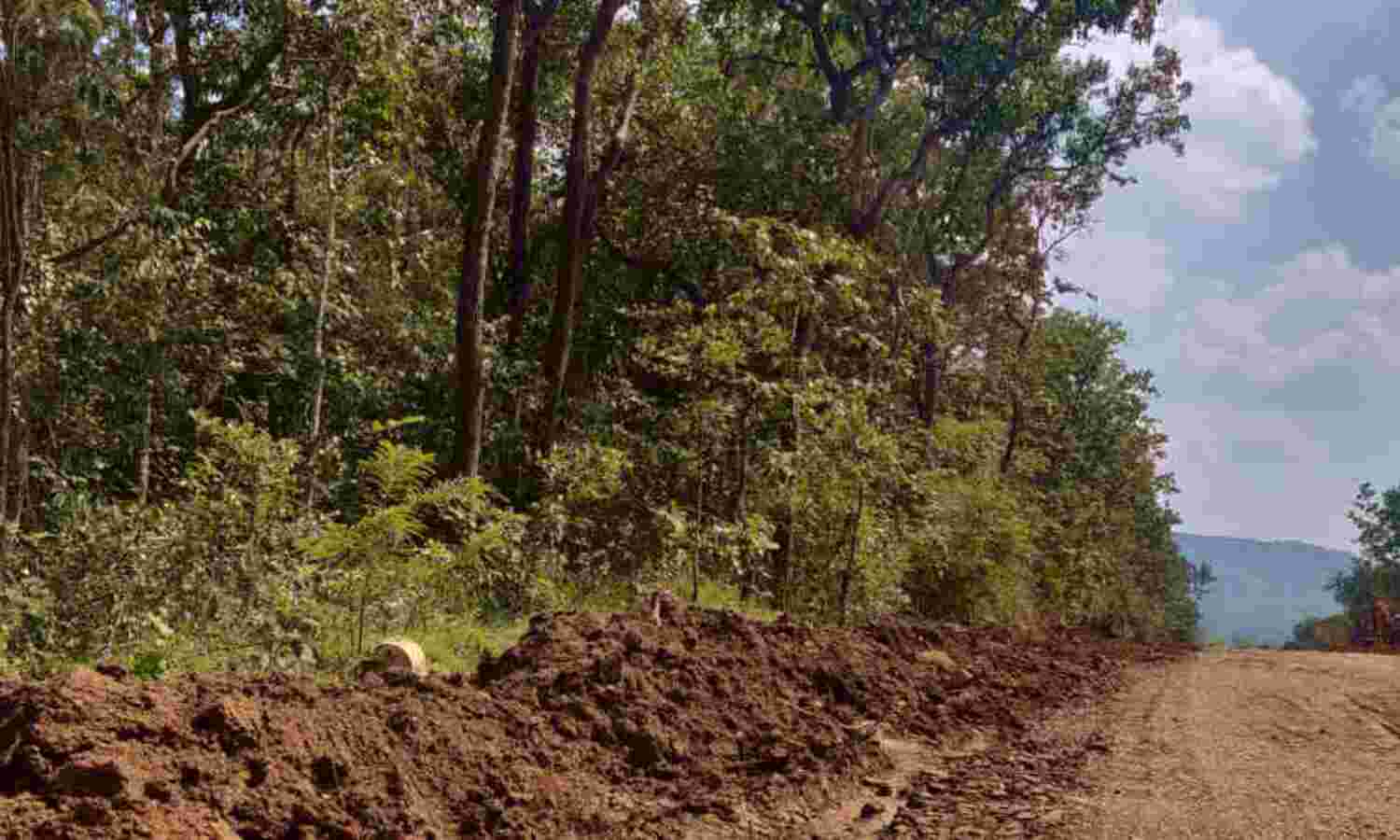

Editor's note: This series was produced in partnership with the Pulitzer Center. The story contains footnotes marked with asterisks
Mumbai and Bengaluru: The risk of meddling with the environment has been laid bare by the COVID-19 pandemic, which has brought the world to its knees. India, in the last six years since July 2014, has approved over 270 projects in and around its most protected environments, including biodiversity hotspots and national parks, according to an IndiaSpend analysis. At the same time, the Centre has watered down environmental safeguards, prompting stakeholders to warn that such interference not only imperils habitat and ecosystems but also endangers public health.
Habitat destruction is changing the patterns of infectious diseases, the World Health Organization (WHO) has been warning for years. This includes a growing number of zoonotic diseases--the ones that spread from animals to humans--such as rabies, Nipah, Ebola, Severe Acute Respiratory Syndrome (SARS), Middle East Respiratory Syndrome (MERS) and COVID-19.
Scientists believe that the novel coronavirus (SARS-CoV-2), which causes COVID-19, likely jumped from bats to humans via an intermediate animal host, before snowballing into a pandemic in a matter of weeks. The highly infectious disease has claimed over 233,000 lives globally, including 1,152 in India, as of 5 p.m. on May 1, 2020.
The chance of coming into contact with zoonotic diseases increases when humans enter biodiversity hotspots--where a large number of animal species are found.
"India is a potential hotspot for emerging and re-emerging infectious diseases," said Abi Tamim Vanak, a senior fellow at the Ashoka Trust for Research in Ecology and the Environment (ATREE), and a DBT/Wellcome Trust India Alliance fellow. "[This is] Because we have [a] very high density of people and livestock amidst areas of high biodiversity, and potentially very high rates of interaction amongst these." Vanak co-leads the OneHealth and Zoonoses programme of the recently announced National Mission on Biodiversity and Human Wellbeing.
The path, for what Vanak describes as potential interaction, has been put on fast-track mode. India's Ministry of Environment, Forest and Climate Change (MoEFCC) has approved 2,256 of the 2,592 proposals that it received for environment clearance (EC)
Of these 2,256 approvals, IndiaSpend looked at 2,115 approvals that had been granted until March 2020. Of these approvals, we analysed data for 2,053 project proposals; the remaining 62 project proposal details could not be analysed due to missing or vague information. The MoEFCC granted 278 approvals for projects in and immediately around Protected Areas (PAs), according to the IndiaSpend analysis; PAs are places such as wildlife sanctuaries and national parks, where human presence is severely restricted by law.
IndiaSpend unearthed this during a year-long investigation scouring data and combined it with ground reporting and expert opinion. Just before the COVID-19 outbreak led to a nationwide shutdown, we spent four months travelling from Uttar Pradesh (UP) to Karnataka to report from projects that the MoEFCC has either granted clearances to, or has expedited to accelerate development.
In the Environment Undone series, we will dive into how some of India's infrastructure projects are damaging its environment and how legal safeguards are failing to stem this damage. Reporting from central India's coal mining areas, the 1,600-km long Western Ghats, the rivers of Bundelkhand, and coastal Karnataka, we show how the projects also have little or no benefits for locals, and are also poorly-conceived. This is the first of a multi-part, data-driven series that explores the environmental, ecological and human cost of India's chosen path of development.
Buffers no more
The MoEFCC granted the maximum number of ECs to three public-sector enterprises, IndiaSpend found in its analysis of 2,053 approved project proposals between July 2014 and March 2020, the details of which are here.
While Oil and Natural Gas Corporation (ONGC) received 42 approvals, Uttarakhand's tourism services provider Garhwal Mandal Vikas Nigam Limited received 21 approvals, and Coal India's subsidiary, Western Coalfields Limited, received 16 clearances.
Three states--Maharashtra (380), Gujarat (316) and Uttar Pradesh (153)--received a majority (849) of the 2,053 ECs between July 2014 and March 2020, our analysis revealed.
Category-wise, 607 ECs went to projects classified as 'Industrial Projects - 2' (neither the Parivesh nor the MoEFCC websites explain what this category includes), we found. Another 435 clearances went to projects classified as 'Infrastructure and Miscellaneous Projects + CRZ' while 316 clearances were granted to projects classified as 'New Construction Projects and Industrial Estates'.

Click here for the interactive map.
Of the 278 project proposals approved in and around 672 PAs, 40 are inside the PAs while 238 are within 10 km of a PA boundary. Human activity is to be severely limited in the immediate vicinity of PA boundaries. While states are permitted to declare the extent of this buffer zone, it is recommended that it be 10 km. Data for PAs were taken from Protected Planet, a website maintained by United Nations agencies based on data provided by national governments.
Maharashtra not only received the most clearances (15) for projects in PAs, but it also got the most approvals (83) for projects within buffer zones, we found. Following Maharashtra, Gujarat (25) and Uttarakhand (21) received the most clearances for project proposals in buffer zones.
MoEFCC joint secretary Richa Sharma told IndiaSpend that the ministry follows the due process while granting approvals. She refused to respond to specific questions about the National Democratic Alliance (NDA) government's environment clearance approval rate or about approvals granted for projects in PAs.
Economic pressure to develop
"My government firmly believes in the path of sustainable development. We are ensuring that development happens without harming the environment," tweeted Prime Minister Narendra Modi on February 17, 2020.
Modi's NDA government has a poor record of caring for the environment since it came to power in 2014. Modi's first term was punctuated by campaigns that incentivised manufacturing (Make in India) and start-ups (Startup India).
Environment Minister Prakash Javadekar has consistently projected a business-friendly image for the MoEFCC, promising to improve the 'ease of doing responsible business' while bringing in faster clearances for businesses in India. Javedekar took additional charge of the ministry for Heavy Industries and Public Enterprises in November 2019.
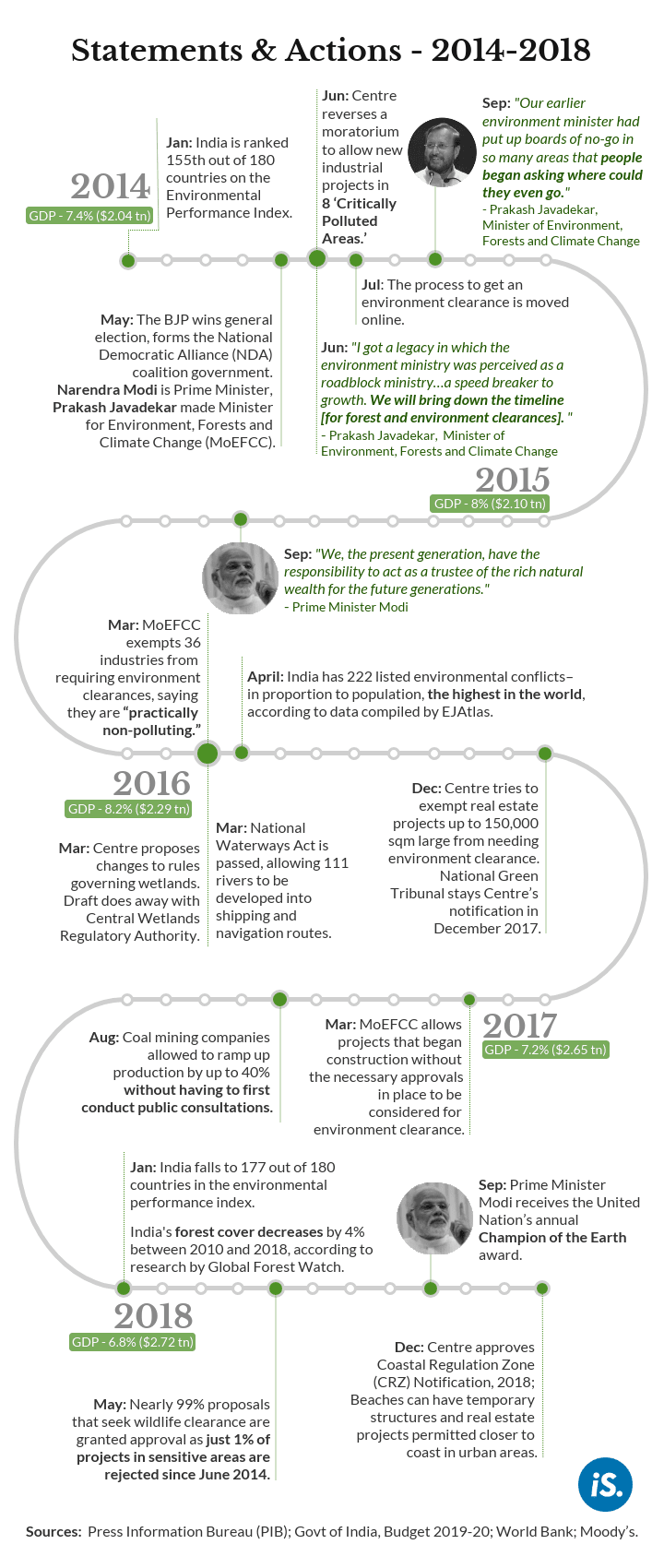
Modi set a target to make India a $5-trillion economy by 2024-25, within 50 days of being re-elected for a second-term. In 2019, India's economy, before the COVID-19 pandemic impact, stood at $2.7 trillion.
The $5-trillion gross domestic product (GDP) goal, say economists, can be achieved by spending on public infrastructure. "It's urgently needed," Jayan Jose Thomas, associate professor of economics at the Indian Institute of Technology-Delhi, told IndiaSpend. "A fall in public investment since around 2011 is one of the key reasons for the current economic slowdown."
Investment in infrastructure projects such as highways, port facilities and power would attract private investment and give a much-needed boost to the manufacturing sector. This, in turn, is key to generate jobs needed to employ India's growing working age population, expected to number over 800 million by 2050.
Stakeholders and environmental observers warn that India's push for infrastructure and attempt to lure investments is resulting in undesirable and ill-conceived projects at the cost of the environment. They say that the environment ministry is rejecting minimal proposals under the guise of development, endangering the last remaining pockets of biodiversity and reserves of natural resources, thereby weakening our resilience to climate change challenges.
"There's an approve-now-deal-with-the-consequences-later approach among successive governments," Kanchi Kohli, senior researcher at the Centre for Policy Research (CPR), told IndiaSpend just before the COVID-19 outbreak in India. "As long as we reach the $5-trillion mark with the economy, there's a belief that everything can be handled after."
Environment or Economy?
India must choose between the environment and the economy, said transport minister Nitin Gadkari in July 2019, when discussing the merits of a poor country spending on mitigating initiatives that help conserve wildlife.
Two months later, in September 2019, Javadekar signaled a change in the government's stance, telling the Parliament that development and the environment must go hand-in-hand to achieve the $5-trillion economy goal. Javadekar's statement came after the United Nations General Assembly's special envoy for climate change, Luis Alfonso de Alba, visited several countries, including India, urging leaders to be more ambitious in their climate change battle.
Earlier too, Javadekar has said that the MoEFCC can balance business interests with environmental ones. He has said that the ministry's move to drastically reduce the time taken to grant environment clearance--down from 640 days pre-2014 to 108 under his leadership--to projects will not impact the quality of their evaluation (more on this later). The 87% environment clearance rate adds little weight to Javadekar's words.
A significant tool in India's armour to ensure that development and environment indeed go hand-in-hand is something called an Environment Impact Assessment (EIA)
In the early days of the COVID-19-induced lockdown in India, the Centre released a new draft of the EIA notification in March 2020. The draft seeks to allow post-facto approval of projects that have gone off the ground before acquiring an environment clearance. It also exempts certain activities, such as extraction, sourcing or borrowing of ordinary earth for linear projects such as roads and pipelines from seeking an EC. The draft also proposes to exempt activities such as dredging and desilting of dams, reservoirs, river, and canals, among other proposed dilutions.
Days later, even as the COVID-19 toll continued to mount, on April 7, 2020, Javadekar announced in a series of tweets that the National Board of Wildlife (NBWL) had granted wildlife clearances for projects including highways, railways and hydroelectricity, in 11 states.
"Right now, a lot of ecologically rich and fragile land is being encroached upon. There are different ways to reach this [GDP of $5 trillion] target without exploiting the country's natural endowment," Saudamini Das of the Institute of Economic Growth told IndiaSpend before the COVID-19 pandemic led to downward revision of growth estimates.
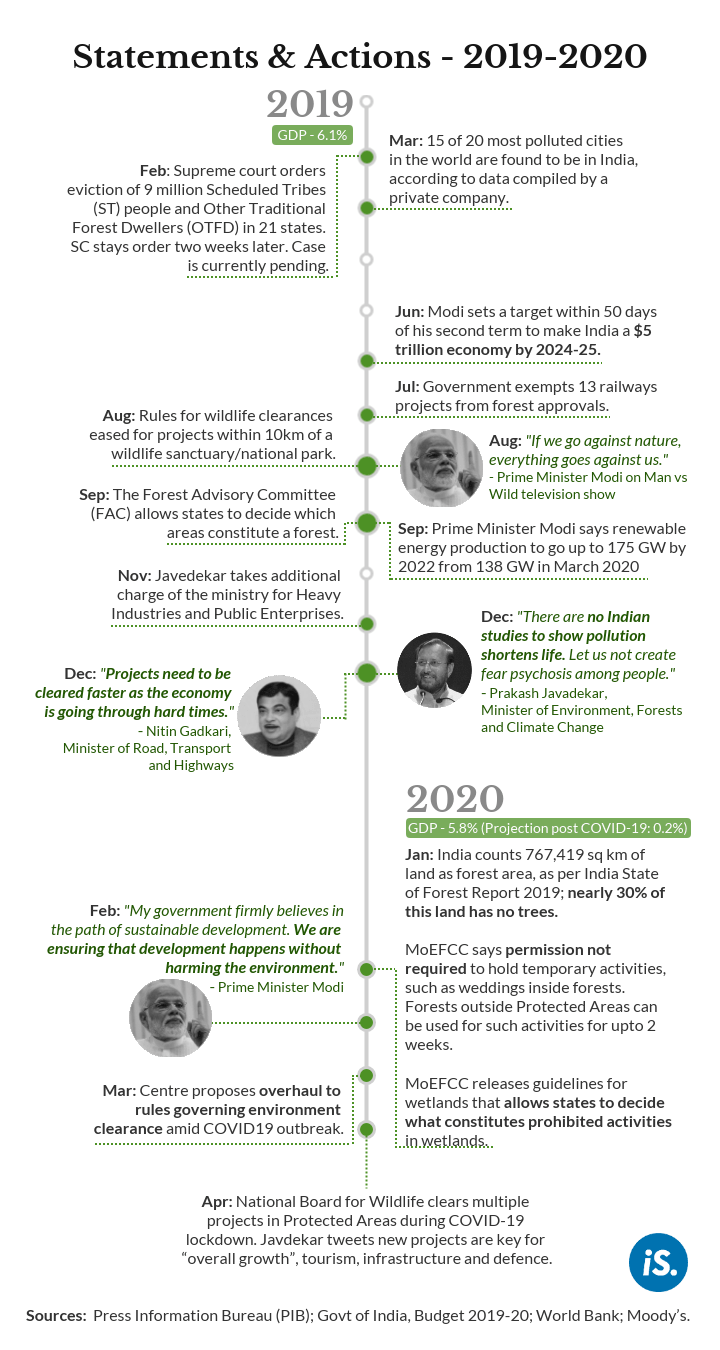
The MoEFCC denied that India's sustainable development is being compromised. "It is my understanding that it [EC approval] is done after a rigorous evaluation process," said Sharma. "When approvals are given, whether for certain townships or industries, there are norms with regards to air, water, land pollution that might happen, and [there are conditions] how to tackle them."
IndiaSpend reached out to Maharashtra's principal secretary (environment) Anil Diggikar and Gujarat's additional chief secretary (forest and environment division) Rajiv Gupta for comment on the large number of ECs for projects in their respective states. This report will be updated as and when they respond.
Counting numbers, undermining value
India's GDP growth slid from 8% in 2015-16 to 7.2% in 2017-18. While India was projected to grow at 7% in 2019-20, credit rating agency Moody's revised it to 0.2% in the aftermath of the COVID-19 pandemic.
India's projected GDP loss due to environmental degradation could be over 1.5% by 2050 if it continues on the 'business as usual' path i.e. high environment degradation and carbon emissions, according to a February 2020 report by the World Wildlife Fund (WWF). Of this, loss due to changes in pollination alone is estimated to be between $0.8 and $3 billion, and up to $9.2 billion due to water scarcity for irrigation, according to the report. The world is staring not only at an environmental crisis but "heading for an economic crisis too", the report summarises.
These estimates are based on the benefits that natural assets such as forests, coastlines and wildlife bring to humans. The report considered the economic benefits such as crop pollination, protection of coasts from flooding and erosion, availability of water, and wood and marine wealth as well as carbon storage that nature provides.
This vital role that nature plays is poorly understood at the policy level.
"We don't seem to have a clear understanding of the linkages between ecological security and long-term livelihood and climate security," Jagdish Krishnaswamy, senior fellow at the Suri Sehgal Centre for Biodiversity and Conservation, ATREE, told IndiaSpend.
"We need policy coherence. There are mixed messages from the government," he said, referring to Gadkari's remark questioning whether a "poor country" like India should be "spending public money" on conservation methods. Gadkari had been talking in the context of having to spend Rs 738 crore to build underpasses as a mitigating measure on a 9-km stretch of National Highway-7 that crosses through Pench Tiger Reserve in Madhya Pradesh.
Building underpasses may cost more than a linear road, but it is imperative to protect animals, including tigers, from being run over on roads encroaching their natural habitat. Maintaining a healthy tiger population is something that Prime Minister Modi celebrates while stressing the importance of tiger conservation.
Protecting tiger reserves alone could yield a per-rupee return of between Rs 347 and Rs 7,488 through the conservation of natural forest and wilderness, according to a 2019 government study by the Centre for Ecological Services Management of the Indian Institute of Forest Management. This suggests there is an economic incentive for governments to maintain safeguards for protected areas.
Krishnaswamy explained that it is "not helpful to put the environment into economic terms, largely because of the irreplaceability of the many ecosystem services" the environment provides. "They simply cannot have monetary value."
For instance, forest cover acts like a sponge as it holds the soil together. This ecosystem absorbs water when it rains and releases it slowly over a period of time. This means consistent supply of water for local communities around such forests, as IndiaSpend reported from Meghalaya in March 2019. Without forests, the water would simply run off. Forests play a critical role in maintaining the water cycle; cutting forests could affect rainfall patterns.
While a rollout of much-needed infrastructure means parts of the environment will necessarily be impinged upon, there are ways to mitigate this. "Development is not easy, but we need to take along all sections of society and the environment together," R Nagaraj, an economist at the Indira Gandhi Institute of Development Research (IGIDR), told IndiaSpend. "We should be using existing institutional mechanisms and minimising conflicts where possible."
Diluting safeguards
Institutional mechanisms such as public consultations and other environment safeguards--perceived to be roadblocks to development--have been gradually eroded or eliminated since 2014. Oil and gas companies, such as ONGC, do not need to seek environment clearances for onshore and offshore exploratory drilling. Polluting industries, including coal and fly ash disposal, are no longer subject to routine inspections, as IndiaSpend reported in January 2020. Instead, they are now expected to self-regulate.
Since 2015, the NDA government has given away 409 sq km forest area--twice the size of Kolkata city--to construct projects (of all kinds from schools to irrigation and mining), according to the e-greenwatch dataset maintained by the MoEFCC and the National Informatics Centre (NIC).
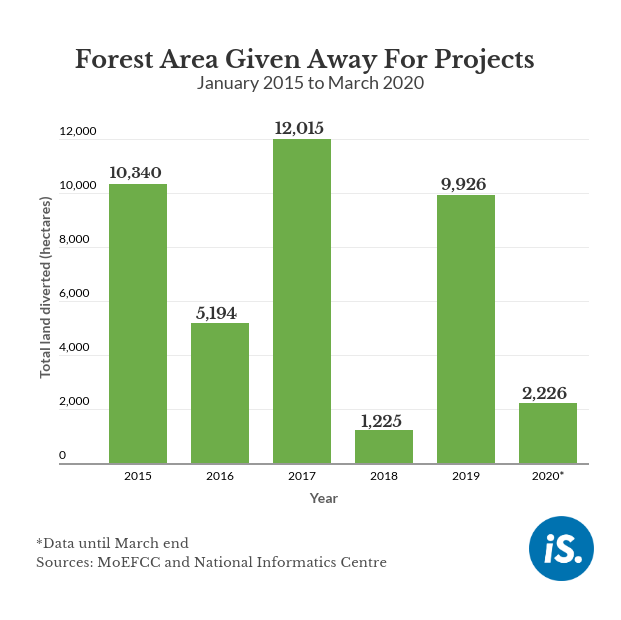
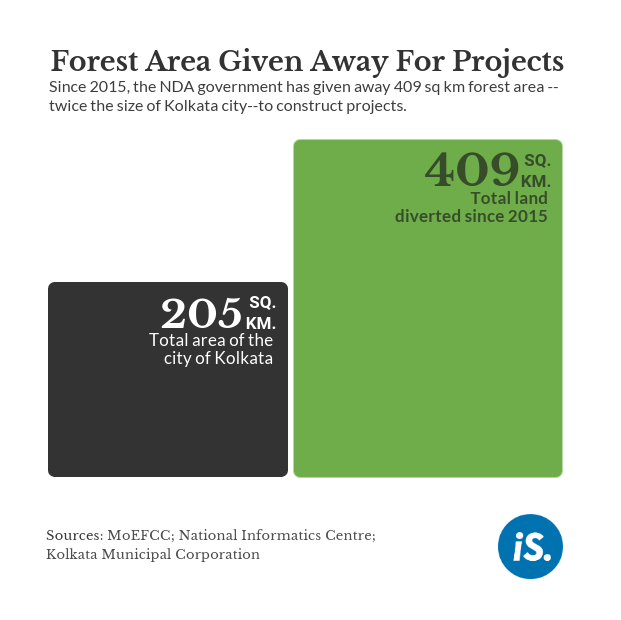
The government has also given its nod to the clearing of hundreds of hectares of pristine forests in central India despite opposition. Government records show environment clearances have been given to corporations despite on-record evidence of locals claiming their signatures on approval documents were taken fraudulently. This evidence is buried in multiple documents uploaded in a format that obfuscates analysis and quantification, IndiaSpend found throughout this year-long investigation. For instance, in this document recording a public hearing that took place with villagers living around the Hasdeo-Arand coal mines in Parsa, Chhattisgarh, one villager (respondent 955) called the project a gag in the name of development, another (responder 983) mentioned coercion to give his consent, another (respondent 1,083) alleged that the coal mine had already polluted the rivers in the area while responder 1,293 said the documents misrepresent the wildlife found there.
In some instances, the Centre has exempted projects in critical wildlife corridors from seeking a clearance altogether, as IndiaSpend reported in July 2019. Elsewhere, dams, mining and infrastructure projects have put India's last pockets of biodiversity and natural resources at risk, including projects in the Western Ghats, home to vital rainforests and rich wildlife.
In 2017, the Expert Appraisal Committee (EAC)
The impact of these policy decisions reflects in the country's standing on the Yale Centre for Environmental Law & Policy's scale that measures the health of each country's environment and ecosystems. India's ranking on the Environmental Performance Index fell from 155 in 2014 to 177 in 2018 among 180 nations. India is now the fourth worst performing country as far as the environment is concerned.
All this is to the detriment of India's people, and despite warnings from scientists, environmentalists and stakeholders. The Intergovernmental Panel on Climate Change (IPCC), the UN body formed to assess science on climate change, predicted more floods, storms and unpredictable rainfall in India in its latest report released in September 2019.
"Recent research shows that extreme weather events--particularly heat waves, floods and droughts--are already at our doorstep and will be the new norm," Roxy Mathew Koll, climate scientist at the Indian Institute of Tropical Meteorology, Pune and a lead author of the report, told IndiaSpend.
Communities in India are under pressure due to global warming, rising sea levels and increasingly erratic monsoon, as IndiaSpend reported earlier. Six hundred million residents of the Indo-Gangetic plain are not just staring at water scarcity but breathing some of the most polluted air in the world. Extreme flooding already threatens an estimated 31 million people living in the coastal areas.
Protectors in jeopardy
It is against this backdrop that protecting India's existing forests, water bodies and natural resources becomes even more critical. Conservationists, activists and other stakeholders taking on this battle are increasingly finding themselves between a rock and a hard place.
India is currently the third most dangerous country for environment defenders, with 23 being killed in 2018, up from 10 in 2015, according to Global Witness, an organisation that campaigns to end environment and human rights abuses.
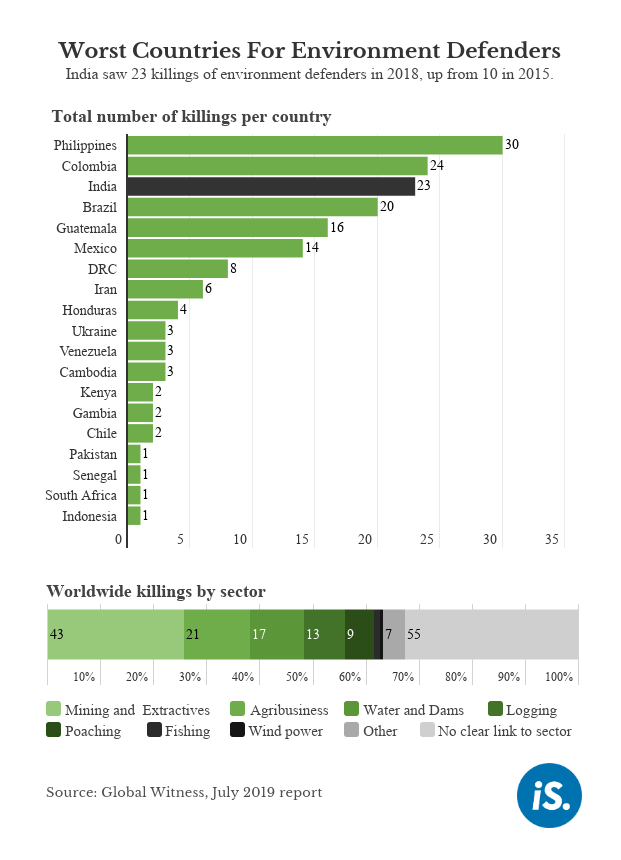
The burden of being a conservator is apparent from the fact that Karnataka legislator Sowmya Reddy thought it was best to resign from the state's wildlife board after it approved, in March 2020, the construction of a railway line through a critical tiger habitat, the Kali Tiger Reserve. "I am not against development, but I cannot support something that is harmful for the environment where there was an alternative, my conscience will not allow me to," Reddy wrote in a Facebook post.
"As NBWL members, our job is [a way] to regulate projects in and around protected areas, not to 'clear' projects as it is perceived to be," conservationist and NBWL standing committee member from 2010 to 2013, Prerna Singh Bindra, told IndiaSpend. "And unfortunately, the ministry, more so now than ever, mandated to protect the environment considers giving away wildlife habitats to development projects, an achievement."
This kind of development is at odds with the pro-conservation message Modi expressed on explorer-presenter Bear Grylls' show Man Vs Wild in August 2019. "We should think about the child who will be born 50 years from now--what right do we have to consume their resources?" Modi said, as he sat surrounded by forest in Uttarakhand's Jim Corbett National Park, on the show.
Poor assessments, problematic rate of approval
Lax consultants, fewer experts and indifferent committees are some of the factors that have contributed to the high approval rate of the MoEFCC's environment clearances, say stakeholders.
EACs--panels charged with making a final decision on whether project proposals are granted environment clearance--are increasingly staffed with non-experts, Ritwick Dutta, an environment lawyer and managing trustee of the Legal Initiative for Forest and Environment (LIFE), told IndiaSpend.
EIA documents, Dutta said, are often riddled with errors as consultants hired to draw up the EIA "copy and paste from other reports". The ministry [of environment] should spot these errors "but they never bother to do that". "There is no interest in an appraisal process anymore," he said. "The EAC is simply a committee that comes to clear projects. It's a rubber stamp authority, that's all."
Expert committees are spending a dwindling amount of time to review each proposal even as the MoEFCC's oversight is diminishing. In some cases, the MoEFCC approved over 100 applications in one day and ignored recommendations by the committee, according to the Centre for Science and Environment's (CSE) damning assessment of clearances granted by the Modi government in its first term.
The maximum, 578 clearances, went to mining and industrial projects in the period between June 2014 until May 2018, CSE's Srestha Banerjee told IndiaSpend. Banerjee authored the CSE fact sheet and is a program manager for its Environmental Governance Unit (Mining Governance and DMF Program). "Environment clearances have increased very significantly for 'other minerals', a category that includes sand, sand-gravel, stone, granite, etc, as per available data," she added. "The average tonnage [metric tonne to extract minerals per annum] granted per year has gone up by six times as compared to the UPA II [second term (2009-14) of the United Progressive Alliance government, NDA's predecessor]."
To expedite the process, more projects are being delegated to state authorities, the CSE report noted. Putting the environment clearance ball in the states' court is problematic, as pointed out by the Centre's Shailesh Nayak Committee, set up in July 2014 to examine gaps in the Coastal Regulation Zone (CRZ)
Having set this precedent, the MoEFCC, which has reduced the number of days it takes to grant environment clearance to 108 days, wants to further bring this down to 70-80 days, Javadekar has said.
The process to get an environment clearance moved online from July 2014. The NDA government proposed amendments to the EIA notification in March 2020, the draft for which has been sent to state governments for their views, as well as for comments from stakeholders. Environmentalists have warned that the new amendments will lead to proposers submitting poor quality environment impact assessments, increase the case for exemptions and reduce the requirement for public consultations--clearing the path for even more and rapidly approved project proposals.
"This latest amendment is really an up-scaling of all that has already been happening," CPR's Kolhi said. "While no institution denies the importance of environment protection, in practice, the decisions enabling the ease of doing business are given higher weightage. In most cases then, environment and local livelihoods are the trade-off for economic growth."
Redress mechanisms vanish
There are other examples where the Centre has favoured business-friendly reform over conservation. In 2016, the MoEFCC decided to exempt real estate projects up to 150,000 sq m--three times the size of Mumbai's Wankhede cricket stadium--from having to obtain environmental clearances, implying they are low risk and in no need of oversight.
The notification was stayed by the National Green Tribunal (NGT) in December 2017, demonstrating how the judicial bench can be an important backstop when potentially significant changes to regulation are attempted.
But the Tribunal's influence is waning.
In 2017, the NGT had all five of its benches--one principal bench in Delhi and at four other regional benches in Kolkata, Bhopal, Pune and Chennai--functional at the same time. In March 2020, just before the COVID-19 outbreak put an end to public gatherings, it functioned out of two benches, one in Delhi and the other in Chennai.
"In the past, there were also efforts to cater to areas where the NGT had not reached, through circuit benches that travelled, for instance, to Shimla, Kerala and Shillong," Supreme Court advocate and managing partner at Enviro Legal Defence Firm, Sanjay Updhayay, told IndiaSpend, "but those days are gone. Now, it's a challenge for even the regular benches to function."
The National Green Tribunal Act 2010 requires a minimum of 10 judicial members and 10 expert members in place at any given time. According to the NGT's website, there are currently just five judicial members (including a chairperson) and four expert members currently working within the green courts.
While the NGT has brought in video conferencing, "this does not compensate for vacant posts left unfilled and the need for as many regional benches as possible" so that those seeking judicial intervention can avoid travelling long distances, Kohli said.
This is one of the most significant ways redressal mechanisms have been weakened over the course of the Modi government, she added. "Earlier, there was more opportunity to ask questions of the government, and for public interface. That has shrunk."
New appointments at the NGT have not translated into more prudent environmental oversight. "There is no effort being made to appoint people who are inclined towards an understanding of the field of environmental law," Upadhyay said, suggesting that this is somewhat by design. "Environmental advocacy is largely seen as an obstructionist institution, an impediment to the rapid growth that the government wants. Ultimately, I don't think there is much interest in bolstering the judiciary right now."
Walk the talk
While India has a delicate task in balancing competing needs, some developed nations are moving towards conservation. In 2016, Canada pledged billions of dollars in its budget to develop water, wastewater and green infrastructure. In 2019, New Zealand's lawmakers approved a 'zero carbon' law aimed at making the country carbon neutral by 2050; the country will use carbon sinks, or natural resources such as forests, to absorb the carbon released due to human activity.
This is what Bhutan does too. The Himalayan nation, which depends on India for the majority of its needs, has declared over 51% of the country's land as protected as a result of which the country absorbs more carbon than it releases.
Closer home, local communities are driving conservation while balancing development needs. In the union territory of Ladakh, a cold desert, a homegrown institute, Himalayan Institute of Alternatives, seeks to find local solutions to local problems. For years now, Ladakhis have used ice stupas to store water from glacial melt to deal with water shortage in the summer months. In Meghalaya, the state government has started a programme to involve local communities in conservation efforts after studies showed the state's rainfall and temperature patterns were changing.
At the policy level, ATREE's Krishnaswamy advocates joint decision-making between ministries. "The environment ministry needs to be as politically powerful as the railways, highways or any other department," he said.
Institute of Economic Growth's Das proposes giving priority to development while maintaining stringent checks and controls. "There needs to be a much more considered assessment of project proposals that want to encroach on core areas," she said. "These areas should be conserved to the maximum extent possible. If these core areas are destroyed, we can never recreate them."
This is the first of a five-part series that explores the environmental, ecological and human cost of India's chosen path of development. You can read the second part here, the third here, the fourth here and the concluding part here.
(Sanghera is an independent journalist and Shetty is a reporting fellow with IndiaSpend. Editing by Marisha Karwa. Data analysis by Pankhuri Kumar)
We welcome feedback. Please write to respond@indiaspend.org. We reserve the right to edit responses for language and grammar.


